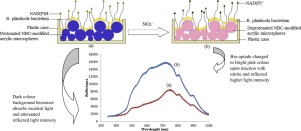Sensors and Actuators B: Chemical ( IF 8.0 ) Pub Date : 2017-09-18 , DOI: 10.1016/j.snb.2017.09.102 Siti Nur Syazni Mohd Zuki , Ling Ling Tan , Nina Suhaity Azmi , Lee Yook Heng , Kwok Feng Chong , Saiful Nizam Tajuddin

|
A microspheres-based microbial optosensor for NO2− ion quantitation was constructed by using immobilized Raoutella planticola (R. planticola), the bacterium expressing NAD(P)H nitrite reductase (NiR) enzyme, which was isolated from local edible bird’s nest (EBN) via microbial technique. The whole cells and the lipophilic Nile Blue chromoionophore (NBC) were physically adsorbed on the self-adhesive photocurable poly(n-butyl acrylate-co-N-acryloxysuccinimide) [poly(nBA-NAS)] microspheres, whilst the reduced co-enzyme NAD(P)H was covalently immobilized on the succinimide-functionalized acrylic microspheres via peptide link to produce a reagentless nitrite biosensing system. As the microbial bio-optode responded to nitrite through colour change from blue to pink, a facile reflectometric approach was adopted to measure reflectance intensity at 639 nm, before and after reaction with nitrite at optimum pH 8. The optosensor could quantify NO2− ion concentration within a dynamic linear response range of 0.5–400 mg L−1 with a limit of detection (LOD) of 0.2 mg L−1. The large surface area to volume ratio of the acrylic microspheres allowed solid-state diffusional mass transfer of the substrate to occur at micro-bio-optode surface, and an equilibrium response was achieved within 5 min. The practical feasibility of using the bio-optode for nitrite assay in food matrix sample showed good agreement with standard ion chromatography method.
中文翻译:

基于固定化亚硝酸盐降解微生物在丙烯酸微球上的全细胞生物光电二极管,用于视觉定量亚硝酸根离子
为NO甲微球为基础的微生物的光传感器2 -离子的定量通过使用固定化的构造Raoutella植(R.植),细菌表达NAD(P)H亚硝酸还原酶(NIR)酶,将其从本地燕窝分离(EBN )通过微生物技术。整个细胞和亲脂性尼罗河蓝生色团(NBC)物理吸附在可自粘的可光固化聚(丙烯酸正丁酯-co - N-丙烯酰氧基琥珀酰亚胺)[poly(nBA-NAS)]微球上,同时还原的辅酶NAD(P)H通过以下方式共价固定在琥珀酰亚胺官能化的丙烯酸微球上肽链产生无试剂的亚硝酸盐生物传感系统。作为微生物的生物光极通过从蓝色到粉红色的颜色变化响应亚硝酸盐,一个浅显的反射计的方法获得通过在639处测定反射率强度,前并在最适pH 8.亚硝酸盐反应后的的光传感器可以NO量化2 -离子浓度在0.5–400 mg L -1的动态线性响应范围内,检出限(LOD)为0.2 mg L -1。丙烯酸微球的表面积与体积之比大,从而使基板的固态扩散传质发生在微生物光电二极管的表面,并在5分钟内实现了平衡响应。在食品基质样品中使用生物光电二极管进行亚硝酸盐测定的实际可行性与标准离子色谱法显示出良好的一致性。











































 京公网安备 11010802027423号
京公网安备 11010802027423号